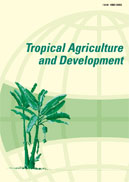All issues

Volume 53 (2009)
- Issue 4 Pages 97-
- Issue 3 Pages 67-
- Issue 2 Pages 33-
- Issue 1 Pages 1-
Predecessor
Volume 53, Issue 1
Displaying 1-4 of 4 articles from this issue
- |<
- <
- 1
- >
- >|
Original Article
-
Albertus Fajar IRAWAN, Yoshinori YAMAMOTO, Akira MIYAZAKI, Tetsushi YO ...2009 Volume 53 Issue 1 Pages 1-6
Published: 2009
Released on J-STAGE: December 14, 2009
JOURNAL FREE ACCESSThe vegetative growth appearance, pith nutrient contents including starch and total sugar contents as well as the subsequent establishment of suckers from various mother palms at different growth stages were investigated. We observed that suckers collected from mother palms at the near flowering and young trunk growth stages in a garden established in the 1970s did not show any significant difference in their vegetative growth characteristics and pith nutrient contents. Nitrogen (2.1-24.4 mg g-1) and potassium (3.6-17.6 mg g-1) contents in the pith of suckers collected at both growth stages of the mother palm were higher than the calcium (0.4-2.5 mg g-1), phosphorus (0.5-2.3 mg g-1) and magnesium (0.2-1.5 mg g-1) contents. Starch and total sugar contents ranged from 26.6 to 64.8 % and 4.4 to 12.9 % in the palms at the near flowering and young trunk growth stages, respectively. No significant differences between them were also observed in the survival rate and newly emerged vegetative organs after establishment for 2.5 months in the nursery, except for the number of newly emerged roots. Suckers from mother palms at the young trunk growth stage were able to show a high survival rate of 73.3 %, although this value was slightly lower than that of the suckers from mother palms approaching the flowering stage (83.3 %). Based on these results, it was concluded that suckers collected from young mother palms in a mature garden where harvest was frequently performed since new planting, could be used as planting materials in addition to those that emerged from mother palms at the near flowering stage.View full abstractDownload PDF (1019K) -
Shinichi KOYAMA, Hisashi URAYAMA, Karunaratne Mudalige Panduka Dahampa ...2009 Volume 53 Issue 1 Pages 7-13
Published: 2009
Released on J-STAGE: December 14, 2009
JOURNAL FREE ACCESSCoconut coir has received much attention as an alternative medium for rockwool in soilless culture. In the present study, the application of used coir medium to soil as a reuse model of organic media was evaluated. Four kinds of organic materials were applied separately at a rate of 20 t ha-1 as follows: new coconut coir (NCC), coir media used in an energy-saving hydroponic system with half the concentration of the standard solution (UHS) and with the full concentration of the standard solution (USS), and compost (COM) made from horse manure and rice straw. Chemical analysis of the organic materials revealed that USS had accumulated two times more Mg, four times more Ca, and forty times more NO3-N than COM. The application of USS increased the soil porosity, cucumber growth and the contents of Mg, Ca and N in cucumber plants. After the 40-day cultivation of cucumber, the residual nutrient contents in the soil with USS application were similar to those with COM application, except for K and NO3-N. The content of NO3-N remaining in the soil with USS application was three times higher (170 kg ha-1) than that with COM. The prolonged retention of NO3-N in the soil with USS may be attributed to the high C/N ratio of coconut coir that led to the immobilization of excess N accumulated in the media, and then gradual release over time. The results suggest that used coir media could be reused as a soil amendment for enhancing porosity as well as a fertilizer providing accumulated nutrients from previous soilless culture.View full abstractDownload PDF (497K) -
Growth Centers, Technological Changes, and Driving ForcesMasahiko MATSUDA2009 Volume 53 Issue 1 Pages 14-27
Published: 2009
Released on J-STAGE: December 14, 2009
JOURNAL FREE ACCESSRice has been the predominant crop in Myanmar (Burma) for a century and is grown all over the country under various farming systems. The production showed several distinct periods of increase after the country’s independence. The present study focused on the latest developing trend in rice production, with the aim of characterizing it in relation to the history of the country. The development processes in Myanmar for the last century were reviewed using statistical data, and three rapid growth phases for rice production were identified: the first in the mid-1970s to early 1980s, the second in the early 1990s, and the third from the late 1990s. Their technological features and major growth areas are discussed within the framework of agro-ecological zoning, which divides the country into four zones: the delta, coastal, central dry, and mountainous zones. The rapid growth in the first and second phases was caused by capital and land-use intensification, respectively, in the delta and central dry zone, which was the political center of the country. In contrast, the third phase has occurred in the mountainous zone, which has been the political periphery. It was also found that, in each of these phases, the growth was driven mainly by the government policy. The latest rice development may imply that the influence of the central government has recently been strengthened and expanded in the mountainous region.View full abstractDownload PDF (1049K)
Short Report
-
Chitose HONSHO, Songpol SOMSRI, Surmsuk SALAKPETCH, Takuya TETSUMURA, ...2009 Volume 53 Issue 1 Pages 28-32
Published: 2009
Released on J-STAGE: December 14, 2009
JOURNAL FREE ACCESSDownload PDF (502K)
- |<
- <
- 1
- >
- >|